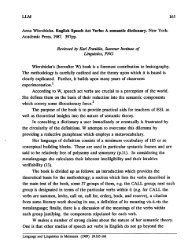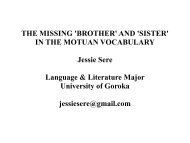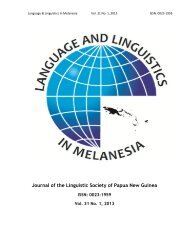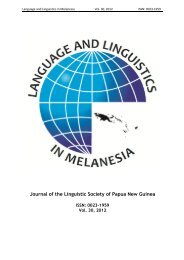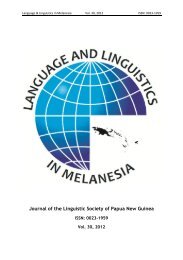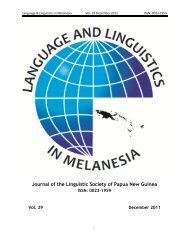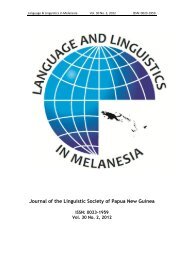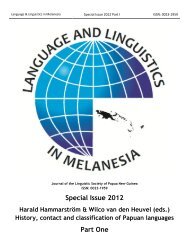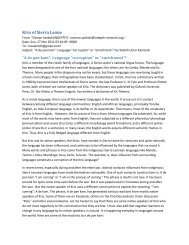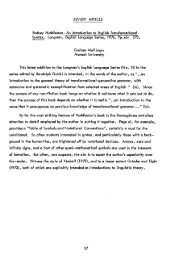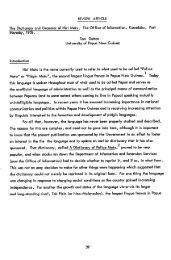Journal of the Linguistic Society of Papua New Guinea
Journal of the Linguistic Society of Papua New Guinea
Journal of the Linguistic Society of Papua New Guinea
Create successful ePaper yourself
Turn your PDF publications into a flip-book with our unique Google optimized e-Paper software.
Language & <strong>Linguistic</strong>s in Melanesia Vol. 30 No. 2, 2012 ISSN: 0023-1959<br />
‘sees’, varies according to individual experience (i.e., level <strong>of</strong> cognitive development, physical and<br />
psychological state, social and cultural environment, and circumstances <strong>of</strong> communication).<br />
Ano<strong>the</strong>r example <strong>of</strong> ‘indeterminacy’ <strong>of</strong> word meanings in use:<br />
What you see as <strong>the</strong> ‘hands’ <strong>of</strong> <strong>the</strong> highwayman below could as well have been <strong>the</strong> fins <strong>of</strong> a fish, or <strong>the</strong><br />
feet <strong>of</strong> a duck in ano<strong>the</strong>r pattern; it is <strong>the</strong> ‘picture’ that each Mind’s Eye sees which makes parts <strong>of</strong> <strong>the</strong><br />
whole to be what <strong>the</strong>y are in each person’s understanding.<br />
Photos taken in a Highlands hotel (FB): East Sepik highwaymen Gents’ toilet sign<br />
Descriptive syntax ignores <strong>the</strong> process <strong>of</strong> generalization which puts parts <strong>of</strong> <strong>the</strong> mosaic image toge<strong>the</strong>r,<br />
shaping <strong>the</strong> sentence meaning in our minds. In order to understand linguistic structures, we must<br />
understand <strong>the</strong> forces that put <strong>the</strong>m toge<strong>the</strong>r – associations by resemblance, contiguity, and<br />
cause/effect, <strong>the</strong> principles <strong>of</strong> human understanding (Hume: 1748). “We do not regard any <strong>of</strong> <strong>the</strong> senses<br />
as Wisdom,” wrote Aristotle, “yet surely <strong>the</strong>se give <strong>the</strong> most authoritative knowledge <strong>of</strong> particulars. But<br />
<strong>the</strong>y do not tell us <strong>the</strong> 'why' <strong>of</strong> anything - e.g., why fire is hot; <strong>the</strong>y only say that it is hot. … Wisdom is<br />
knowledge about certain principles and causes” (Aristotle: Metaphysics, Book I). Detailed accounts <strong>of</strong><br />
and descriptions <strong>of</strong> linguistic structures provide us with useful information that sharp senses <strong>of</strong> hearing<br />
and sight can give us. They cannot explain <strong>the</strong>ir ‘principles and causes’ – <strong>the</strong> ‘why’s <strong>of</strong> <strong>the</strong> constantly<br />
changing grammars.<br />
III. DIALECTICAL SYNTAX<br />
Dialectical syntax describes <strong>the</strong> different ways societies devised <strong>of</strong> doing <strong>the</strong> same thing – generalizing,<br />
or thinking (i.e., associating word-meanings by resemblance, contiguity and cause/effect, thus<br />
syn<strong>the</strong>sizing larger chunks <strong>of</strong> meaning – phrases and clauses). This Rational Language Mechanism, so<br />
elegant in its simplicity, operates without exception in all human languages. Different grammars use<br />
different tactics to build <strong>the</strong>ir sentence mosaics, but <strong>the</strong> strategy <strong>of</strong> syn<strong>the</strong>sizing complex<br />
generalizations through only three types <strong>of</strong> association is universal. Look, for example, how different<br />
languages express <strong>the</strong> same causal relationship in so many changing ways:<br />
34



